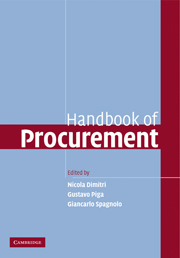Book contents
- Frontmatter
- Contents
- List of figures
- List of tables
- List of contributors
- Preface
- Part I Preliminary Issues
- Part II General Strategic Principles
- Part III Competitive Tendering Strategies
- Part IV Attracting and Screening Participants
- 10 Pricing and other business strategies for e-procurement platforms
- 11 Fostering participation
- 12 Scoring rules
- 13 Managing risky bids
- Part V Preventing Collusion and Corruption
- Part VI Dynamic Forces and Innovation
- Glossary
- Index
- References
10 - Pricing and other business strategies for e-procurement platforms
Published online by Cambridge University Press: 04 November 2009
- Frontmatter
- Contents
- List of figures
- List of tables
- List of contributors
- Preface
- Part I Preliminary Issues
- Part II General Strategic Principles
- Part III Competitive Tendering Strategies
- Part IV Attracting and Screening Participants
- 10 Pricing and other business strategies for e-procurement platforms
- 11 Fostering participation
- 12 Scoring rules
- 13 Managing risky bids
- Part V Preventing Collusion and Corruption
- Part VI Dynamic Forces and Innovation
- Glossary
- Index
- References
Summary
Introduction
The pace of innovation in information and communication technologies over recent decades had a dramatic impact for the organization of industries. Traditional vertical relationships are now challenged by new forms of electronic intermediation proposed by e-marketplaces, exploiting the possibilities offered by the Internet. Foreseen improvements in reliability, security and process innovation open the prospect for a complete reshaping of supply chain management via e-commerce. According to the European e-Business Report (e-Business W@tch) in 2004, and based on the five largest EU countries, 23 percent of firms were buying more than 5 percent of their supply on-line. Eleven percent of the firms were using some e-marketplace for procurement, with leading figures for ICT, transport equipment, chemicals and electronics.
Behind these figures lies a huge diversity of situations, with services ranging from simple search and matching services to fully integrated supply chain management. For instance eMarket Services (www.emarketservices.com) describes an e-marketplace as ‘an aggregation of information portals, trading exchanges and collaboration tools.’ This diversity comes with equally large attrition rates, highlighting the ‘winners-take-all’ nature of electronic intermediation activities. While there is a high rate of entry, few remain after some years, and the collapse of the Internet bubble is a reminder to all that profitability may not be at the initially expected level. To some extent these changes can be traced back to a drastic change in the cost structure of intermediation, with a huge reduction in the variable costs of information processing.
- Type
- Chapter
- Information
- Handbook of Procurement , pp. 249 - 266Publisher: Cambridge University PressPrint publication year: 2006
References
- 3
- Cited by



